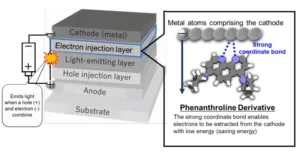New Organic Light-Emitting-Diode Material for realizing low-energy, long-life flexible displays. NHK Science and Technology Research Laboratories (NHK STRL) is conducting R&D on organic light-emitting diodes (OLEDs)1 for realizing flexible displays that can be folded or rolled up.
To extend the lifetime of flexible displays formed using plastic film, NHK STRL has already developed a stable electron injection layer (EIL) material, which supplies electrons from the cathode to the light-emitting material, and that is also resistant to the effects of moisture and oxygen.
And now, we have developed a new phenanthroline derivative2 for the EIL*. This new material reduces the power consumption of flexible displays while maintaining their lifetime. The power consumption of an OLED display can be reduced by reducing the energy required for the EIL to extract electrons from the cathode. Lithium is widely used as the material for OLED EILs, but the new phenanthroline derivative forms strong coordination bonds3 with the metal atoms comprising the cathode, enabling electrons to be extracted with less energy than is required with lithium.
We have successfully used this material to prototype an OLED device that exhibits the world?s highest level of power efficiency. The material is also stable and resistant to degradation from oxygen or moisture, so it will contribute to extending the lifetime of flexible displays.
These research results were published in Nature Communications4 on July 24th We are continuing R&D to create flexible displays with longer lifespan and lower power consumption as soon as possible. This material was developed in collaboration with Nippon Shokubai Co. Ltd.
OLED structure and characteristics of the phenanthroline derivative
1) Diodes that emit light when electrical current is passed through a layered structure containing certain organic compounds.
2) An organic material containing nitrogen, with the characteristic that electrons from the nitrogen can be supplied to the metal easily.
3) A type of chemical bond formed when an organic material donates electrons to a metal.

